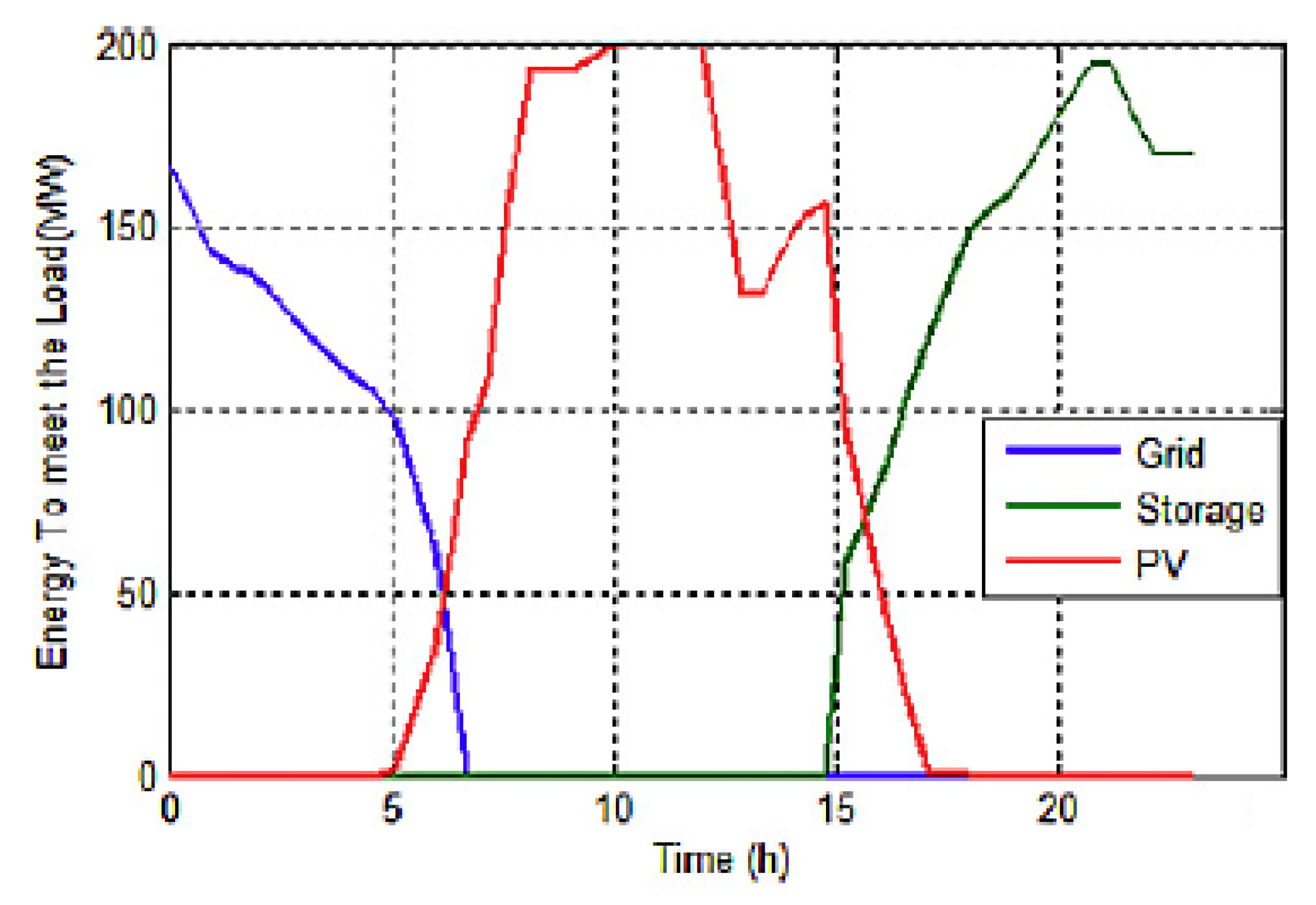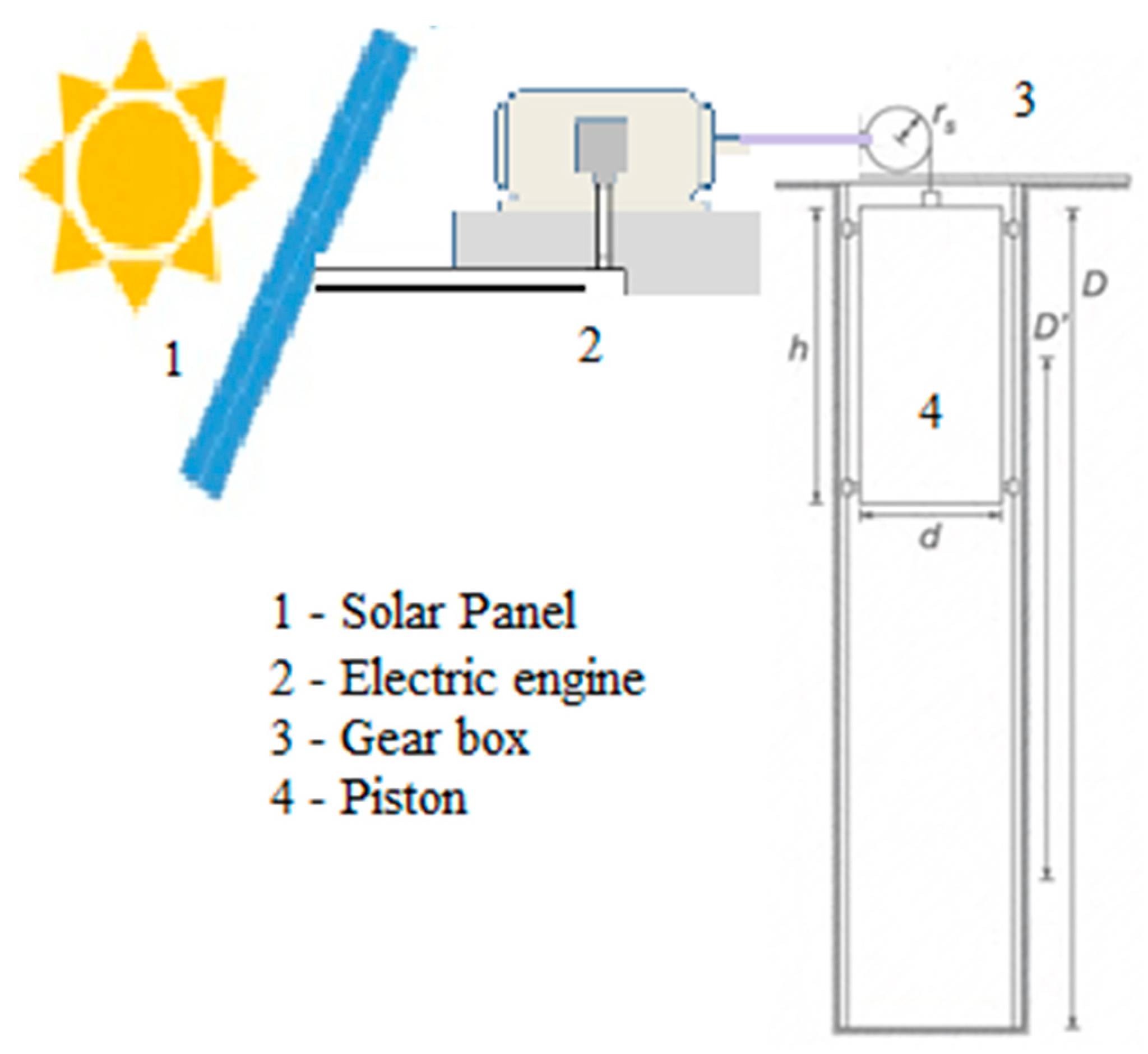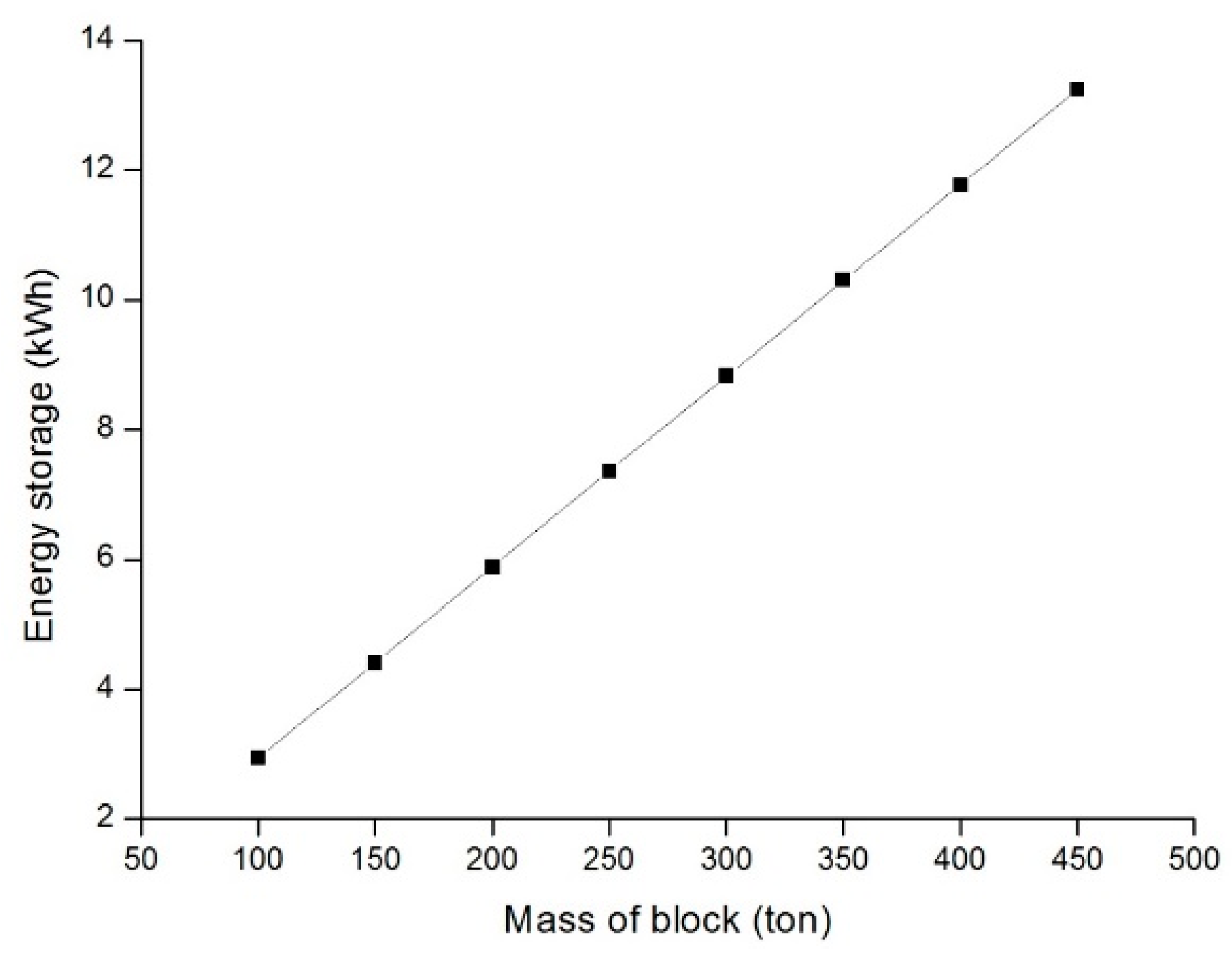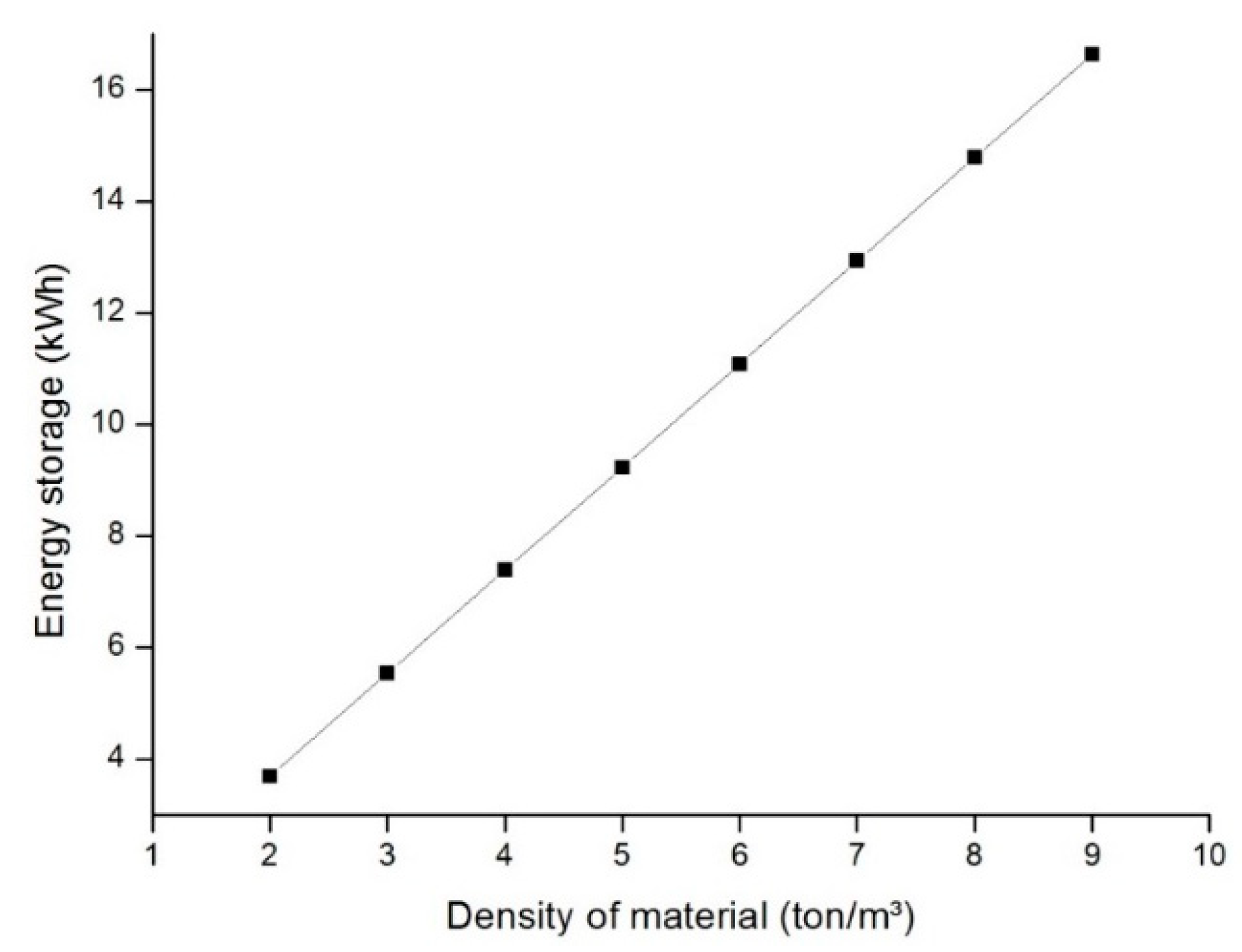Storage Gravitational Energy for Small Scale Industrial and Residential Applications
Abstract
1. Introduction
2. Background
3. Small Scale Energy Storage: Modeling the System
3.1. System Sizing
4. Storage System Characteristics and Applications
5. Conclusions
Author Contributions
Funding
Acknowledgments
Conflicts of Interest
References
- Ren, G.; Liu, J.; Wan, J.; Guo, Y.; Yu, D. Overview of wind power intermittency: Impacts, measurements, and mitigation solutions. Appl. Energy 2017, 204, 47–65. [Google Scholar] [CrossRef]
- Kousksou, T.; Bruel, P.; Jamil, A.; el Rhafiki, T.; Zeraouli, Y. Energy storage, Applications and challenges. Sol. Energy Mater. Sol. Cells 2014, 120, 59–80. [Google Scholar] [CrossRef]
- Mohammedi, A.; Rekioua, D.; Rekioua, T.; EddineMebarki, N. Comparative assessment for the feasibility of storage bank in small scale power photovoltaic pumping system for building application. Energy Convers. Manag. 2018, 172, 579–587. [Google Scholar] [CrossRef]
- Zaouche, F.; Rekioua, D.; Gaubert, J.; Mokrani, Z. Supervision and control strategy for photovoltaic generators with battery storage. Int. J. Hydrogen Energy 2017, 42, 19536–19555. [Google Scholar] [CrossRef]
- Ruoso, A.C.; Bitencourt, L.C.; Sudati, L.U.; Klunk, M.A.; Caetano, N.R. New Parameters for the Forest Biomass Waste Ecofirewood Manufacturing Process Optimization. Periódico Tchê Química 2019, 16, 560–571. [Google Scholar]
- Cataluña, R.; Shah, Z.; Venturi, V.; Caetano, N.R.; da Silva, B.P.; Azevedo, C.M.N.; Silva, R.; Suarez, P.A.Z.; Oliveira, L.P. Production process of di-amyl ether and its use as an additive in the formulation of aviation fuels. Fuel 2018, 228, 226–233. [Google Scholar] [CrossRef]
- Caetano, N.R.; Venturini, M.S.; Centeno, F.R.; Lemmertz, C.K.; Kyprianidis, K.G. Assessment of mathematical models for prediction of thermal radiation heat loss from laminar and turbulent jet non-premixed flames. Therm. Sci. Eng. Prog. 2018, 7, 241–247. [Google Scholar] [CrossRef]
- Venturini, M.S.; Bageston, J.V.; Caetano, N.R.; Peres, L.V.; Bencherif, H.; Schuch, N.J. Mesopause region temperature variability and its trend in southern Brazil. Ann. Geophys. 2018, 36, 301–310. [Google Scholar] [CrossRef]
- Klunk, M.; Damiani, L.H.; Feller, G.; Rey, M.F. Geochemical modeling of diagenetic reactions in Snorre Field reservoir sandstones: A comparative study of computer codes. Braz. J. Geol. 2015, 45, 29–40. [Google Scholar] [CrossRef]
- Caetano, N.R.; Silva, B.P. Technical and Economic Viability for the Briquettes Manufacture. Defect Diffus. Forum 2017, 380, 218–226. [Google Scholar]
- Caetano, N.R.; Stapasolla, T.Z.; Peng, F.B.; Schneider, P.S.; Pereira, F.M.; Vielmo, A.H. Diffusion Flame Stability of Low Calorific Fuels. Defect Diffus. Forum 2015, 362, 29–37. [Google Scholar] [CrossRef]
- Caetano, N.R.; Da Silva, L.F.F. A comparative experimental study of turbulent non premixed flames stabilized by a bluff-body burner. Exp. Therm. Fluid Sci. 2015, 63, 20–33. [Google Scholar] [CrossRef]
- Caetano, N.R.; Cataluña, R.; Vielmo, H.A. Analysis of the Effect on the Mechanical Injection Engine Using Doped Diesel Fuel by Ethanol and Bio-Oil. Int. Rev. Mech. Eng. 2015, 9, 124–128. [Google Scholar] [CrossRef]
- Caetano, N.R.; Soares, D.; Nunes, R.P.; Pereira, F.M.; Schneider, P.S.; Vielmo, H.A.; van der Laan, F.T. A comparison of experimental results of soot production in laminar premixed flames. Open Eng. 2015, 5. [Google Scholar] [CrossRef]
- Reddy, S.S. Optimal scheduling of thermal-wind-solar power system with storage. Renew. Energy 2017, 101, 1357–1368. [Google Scholar] [CrossRef]
- Grzesiak, W. Innovative system for energy collection and management integrated within a photovoltaic module. Sol. Energy 2016, 132, 442–452. [Google Scholar] [CrossRef]
- Ju, X.; Xu, C.; Hu, Y.; Han, X.; Wei, G.; Du, X. A review on the development of photovoltaic/concentrated solar power (PV-CSP) hybrid systems. Sol. Energy Mater. Sol. Cells 2017, 161, 305–327. [Google Scholar] [CrossRef]
- Cataluña, R.; Shah, Z.; Pelisson, L.; Caetano, N.R.; Da Silva, R.; Azevedo, C. Biodiesel Glycerides from the Soybean Ethylic Route Incomplete Conversion on the Diesel Engines Combustion Process. J. Braz. Chem. Soc. 2017. [Google Scholar] [CrossRef]
- Ondeck, A.D.; Edgar, T.F.; Baldea, M. Impact of rooftop photovoltaics and centralized energy storage on the design and operation of a residential CHP system. Appl. Energy 2018, 222, 280–299. [Google Scholar] [CrossRef]
- Suberu, M.Y.; Mustafa, M.W.; Bashir, N. Energy storage systems for renewable energy power sector integration and mitigation of intermittency. Renew. Sustain. Energy Rev. 2014, 35, 499–514. [Google Scholar] [CrossRef]
- Singh, S.; Singh, M.; Kaushik, S.C. Feasibility study of an islanded microgrid in rural area consisting of PV, wind, biomass and battery energy storage system. Energy Convers. Manag. 2016, 128, 178–190. [Google Scholar] [CrossRef]
- Akbari, H.; Browne, M.C.; Ortega, A.; Huang, M.J.; Hewitt, N.J.; Norton, B.; McCormack, S.J. Efficient energy storage technologies for photovoltaic systems. Sol. Energy 2018. [Google Scholar] [CrossRef]
- Castillo, A.; Gayme, D.F. Grid-scale energy storage applications in renewable energy integration, A survey. Energy Convers. Manag. 2014, 87, 885–894. [Google Scholar] [CrossRef]
- Jallouli, R.; Krichen, L. Sizing, techno-economic and generation management analysis of a stand alone photovoltaic power unit including storage devices. Energy 2012, 40, 196–209. [Google Scholar] [CrossRef]
- Akinyele, D.O.; Rayudu, R.K. Review of energy storage technologies for sustainable power networks. Sustain. Energy Technol. Assess. 2014, 8, 74–91. [Google Scholar] [CrossRef]
- Parastegari, M.; AllahHooshmand, R.; Khodabakhshian, A.; HosseinZar, A. Joint operation of wind farm, photovoltaic, pump-storage and energy storage devices in energy and reserve markets. Int. J. Electr. Power Energy Syst. 2015, 64, 275–284. [Google Scholar] [CrossRef]
- Berrada, A.; Loudiyi, K.; Garde, R. Dynamic modeling of gravity energy storage coupled with a PV energy plant. Energy 2017, 134, 323–335. [Google Scholar] [CrossRef]
- Gonzatti, F.; Farret, F.A. Mathematical and experimental basis to model energy storage systems composed of electrolyzer, metal hydrides and fuel cells. Energy Convers. Manag. 2017, 132, 241–250. [Google Scholar] [CrossRef]
- Rohit, A.K.; Rangnekar, S. An overview of energy storage and its importance in Indian renewable energy sector: Part II—Energy storage applications, benefits and market potential. J. Energy Storage 2017, 13, 447–456. [Google Scholar] [CrossRef]
- Dostál, Z.; Ladányi, L. Demands on energy storage for renewable power sources. J. Energy Storage 2018, 18, 250–255. [Google Scholar] [CrossRef]
- Aissou, S.; Rekioua, D.; Mezzai, N.; Rekioua, T.; Bacha, S. Modeling and control of hybrid photovoltaic wind power system with battery storage. Energy Convers. Manag. 2015, 89, 615–625. [Google Scholar] [CrossRef]
- Amirante, R.; Cassone, E.; Distaso, E.; Tamburran, P. Overview on recent developments in energy storage, Mechanical, electrochemical and hydrogen technologies. Energy Convers. Manag. 2017, 132, 372–387. [Google Scholar] [CrossRef]
- Balcombe, P.; Rigby, D.; Azapagic, A. Investigating the importance of motivations and barriers related to microgeneration uptake in the UK. Appl. Energy 2014, 130, 403–418. [Google Scholar] [CrossRef]
- McKenna, E.; McManus, M.; Cooper, S.; Thomson, M. Economic and environmental impact of lead-acid batteries in grid-connected domestic PV systems. Appl. Energy 2013, 104, 239–249. [Google Scholar] [CrossRef]
- Mcmanus, M.C. Environmental consequences of the use of batteries in low carbon systems: The impact of battery production. App. Energy 2012, 93, 288–295. [Google Scholar] [CrossRef]
- Hawkes, A.D. Estimating marginal CO2 emissions rates for national electricity systems. Energy Policy 2010, 38, 5977–5987. [Google Scholar] [CrossRef]
- Azhgaliyeva, D. Energy Storage and Renewable Energy Deployment, Empirical Evidence from OECD countries. Energy Procedia 2019, 158, 3647–3651. [Google Scholar] [CrossRef]
- Rosa, F.S.; Padilha, A.; Caetano, N.R. Inventory Management: A case study applied in a hospital pharmacy. Espacios 2016, 37, 22. [Google Scholar]
- Aneke, M.; Wang, M. Energy storage technologies and real life applications—A state of the art review. Appl. Energy 2016, 179, 350–377. [Google Scholar] [CrossRef]
- Botha, C.D.; Kamper, M.J. Capability study of dry gravity energy storage. J. Energy Storage 2019, 23, 159–174. [Google Scholar] [CrossRef]
- Lan, H.; Bai, Y.; Wen, S.; Yu, D.; Hong, Yi.; Dai, J.; Cheng, P. Modeling and stability analysis of hybrid pv/diesel/ess in ship power system. Inventions 2016, 1, 5. [Google Scholar] [CrossRef]
- Arani, A.A.K.; Zaker, B.; Gharehpetian, G.B. A control strategy for flywheel energy storage system for frequency stability improvement in islanded microgrid. Iran. J. Electr. Electron. Eng. 2017, 13, 10–21. [Google Scholar]
- Jayasinghe, S.G.; Meegahapola, L.; Fernando, N.; Jin, Z.; Guerrero, J.M. Review of ship microgrids: System architectures, storage technologies and power quality aspects. Inventions 2017, 2, 4. [Google Scholar] [CrossRef]
- Šonský, J.; Tesař, V. Design of a stabilised flywheel unit for efficient energy storage. J. Energy Storage 2019, 24, 100765. [Google Scholar] [CrossRef]
- Arani, A.A.K.; Gharehpetian, G.B.; Abedi, M. Review on energy storage systems control methods in microgrids. Int. J. Electr. Power Energy Syst. 2019, 107, 745–757. [Google Scholar] [CrossRef]
- Barnes, F.S.; Levine, J.G. Large Energy Storage Systems Handbook; CRC Press: Boca Raton, FL, USA, 2011. [Google Scholar]
- Matos, C.R.; Carneiro, J.F.; Silva, P.P. Overview of large-scale underground energy storage technologies for integration of renewable energies and criteria for reservoir identification. J. Energy Storage 2019, 21, 241–258. [Google Scholar] [CrossRef]
- He, W.; Luo, X.; Evans, D.; Busby, J.; Garvey, S.; Parkes, D.; Wang, J. Exergy storage of compressed air in cavern and cavern volume estimation of the large-scale compressed air energy storage system. Appl. Energy 2017, 208, 745–757. [Google Scholar] [CrossRef]
- Budt, M.; Wolf, D.; Span, R.; Yan, J. A review on compressed air energy storage: Basic principles, past milestones and recent developments. Appl. Energy 2016, 170, 250–268. [Google Scholar] [CrossRef]
- Wang, J.; Lu, K.; Ma, L.; Wang, J.; Dooner, M.; Miao, S.; Jian, L.; Wang, D. Overview of compressed air energy storage and technology development. Energies 2017, 10, 991. [Google Scholar] [CrossRef]
- Wang, J.; Ma, L.; Lu, K.; Miao, S.; Wang, D.; Wang, J. Current research and development trend of compressed air energy storage. Syst. Sci. Control Eng. 2017, 5, 434–448. [Google Scholar] [CrossRef]
- Rehman, S.; Al-Hadhrami, L.M.; MahbubAlam, M. Pumped hydro energy storage system: A technological review. Renew. Sustain. Energy Rev. 2015, 44, 586–598. [Google Scholar] [CrossRef]
- Menéndez, J.; Ordóñez, A.; Álvarez, R.; Loredo, J. Energy from closed mines: Underground energy storage and geothermal applications. Renew. Sustain. Energy Rev. 2019, 108, 498–512. [Google Scholar] [CrossRef]
- Winde, F.; Kaiser, F.; Erasmus, E. Exploring the use of deep level gold mines in South Africa for underground pumped hydroelectric energy storage schemes. Renew. Sustain. Energy Rev. 2017, 78, 668–682. [Google Scholar] [CrossRef]
- Pujades, E.; Orban, P.; Bodeux, S.; Archambeau, P.; Erpicum, S.; Dassargues, A. Underground pumped storage hydroelectricity using abandoned works (deep mines or open pits) and the impact on groundwater flow. Hydrogeol. J. 2016, 24, 1531–1546. [Google Scholar] [CrossRef]
- Wong, I.H. An underground pumped storage scheme in the Bukit Timah granite of Singapore. Tunn. Undergr. Space Tech. 1996, 11, 485–489. [Google Scholar] [CrossRef]
- Meyer, F. Storing Wind Energy Underground; FIZ Karlsruhe–Leibnz Institute for Information Infrastructure: Eggenstein Leopoldshafen, Germany, 2013. [Google Scholar]
- Cazzaniga, R.; Cicua, M.; Marrana, T.; Rosa-Clot, M.; Rosa-Clota, P.; Tina, G.M. DOGES, Deep ocean gravitational energy storage. J. Energy Storage 2017, 14, 264–270. [Google Scholar] [CrossRef]
- Slocum, A.H.; Fennell, G.E.; Dundar, G.; Hodder, B.G.; Meredith, J.D.C. Ocean renewable energy storage (ORES) system: Analysis of an undersea energy storage concept. Proc. IEEE 2013, 101, 906–924. [Google Scholar] [CrossRef]
- Gravity Power–Grid Scale Energy Storage, 2017. Available online: http://www.gravitypower.net/ (accessed on 1 July 2019).
- Loudiyi, K.; Berrada, A. Experimental Validation of Gravity Energy Storage Hydraulic Modeling. Energy Procedia 2017, 134, 845–854. [Google Scholar] [CrossRef]
- Berrada, A.; Loudiyi, K.; Zorkani, I. Dynamic modeling and design considerations for gravity energy storage. J. Clean. Prod. 2017, 159, 336–345. [Google Scholar] [CrossRef]
- Berrada, A.; Loudiyi, K.; Zorkani, I. System design and economic performance of gravity energy storage. J. Clean. Prod. 2017, 156, 317–326. [Google Scholar] [CrossRef]
- Berrada, A.; Loudiyi, K.; Zorkani, I. Profitability, risk, and financial modeling of energy storage in residential and large scale applications. Energy 2017, 119, 94–109. [Google Scholar] [CrossRef]
- Berrada, A.; Loudiyi, K.; Zorkani, I. Valuation of energy storage in energy and regulation markets. Energy 2016, 115, 1109–1118. [Google Scholar] [CrossRef]
- Oldenmenger, A.W. Highrise Energy Storage Core: Feasibility Study for a Hydro-Electrical Pumped Energy Storage System in a Tall Building. Master’s Thesis, Delft University of Technology, Delft, Holland, 2013. [Google Scholar]
- Berrada, A.; Loudiyi, K.; Zorkani, I. Toward an improvement of gravity energy storage using compressed air. Energy Procedia 2017, 134, 855–864. [Google Scholar] [CrossRef]
- Escovale Consultancy Services. 2016. Available online: http://www.escovale.com/GBES.php (accessed on 1 July 2019).
- Escombe, F. GBES—Ground-Breaking Energy Storage (GBES-01). 2016. Available online: http://www.escovale.com/downloads/GBES-01-Introduction.pdf (accessed on 1 July 2019).
- Heindl Energy Storage. 2019. Available online: https://heindl-energy.com (accessed on 1 July 2019).
- Letcher, T.M.; Law, R.; Reay, D. Storing Energy: With Special Reference to Renewable Energy Sources; Oxford: Elsevier: Oxford, UK, 2016. [Google Scholar]
- Ares. The Power of Gravity. 2019. Available online: https://www.aresnorthamerica.com/ (accessed on 1 July 2019).
- Sandru, O. Gravel Energy Storage System Funded by Bill Gates, the Green Optimistic. 2012. Available online: www.greenoptimistic.com (accessed on 1 July 2019).
- Blair, C. Gravitricity–Storing Power as Well as Energy. 2016. Available online: http://www.all-energy.co.uk/Conference/Download-2016-Presentations/ (accessed on 1 July 2019).
- Gravitricity. 2019. Available online: https://www.gravitricity.com/ (accessed on 1 July 2019).
- Bungane, B. Gravitricity Sets Sights on South Africa to Test Green Energy Tech. 2018. Available online: https://www.esi-africa.com/gravitricity-sets-sights-south-africa-test-green-energy-tech/ (accessed on 1 July 2019).
- Huisman. Gravitricity Teams up with Worldwide Lifting, Drilling and Subsea Specialists Huisman to Build Prototype Energy Store. 2018. Available online: https://www.huismanequipment.com/ (accessed on 1 July 2019).
- MGH–Deep Sea Energy Storage. 2015. Available online: http://www.mgh-energy.com/ (accessed on 1 July 2019).
- Stratosolar. 2019. Available online: http://www.stratosolar.com/ (accessed on 1 July 2019).
- Morstyn, T.; Chilcott, M.; Mcculloch, M.D. Gravity Energy Storage with Suspended Weights for Abandoned Mine Shafts. Appl. Energy 2019, 239, 201–206. [Google Scholar] [CrossRef]





| Storage Technology | Energy Density Wh/l | Power Density W/l | Energy Rating Wh | Power Rating W | Discharge Time h | Life Time years | Roundtrip Efficiency % |
|---|---|---|---|---|---|---|---|
| FES | 20–80 | 103–2·103 | - | <2.5·105 | <0.25 | 15 | 85–95 |
| CAES | 0.4–20 | 0.04–10 | 108 | 5·106–3·108 | 1–24 | 20–60 | 50–89 |
| PHES | 0.13–0.5 | 0.01–0.12 | 106–2·1010 | 108–5·109 | 1–24 | 40–60 | 65–87 |
| UOSS | - | - | <109 | <109 | 1–10 | n/D | 65–90 |
| GPM | 1.6 | 3.13 | 1.6·109–6.4·109 | 4·107–1.6·109 | 1–4 | 30+ | 75–80 |
| HHS | - | - | 109–1010 | 2·107–2.75·109 | 1–24 | 40+ | 80 |
| GBES | - | - | <2·1010 | 108 | 24 | 40+ | 80 |
| ARES | - | - | <6·109 | 108–3·109 | 2–24 | 40+ | 75–86 |
| Gravitricity | - | - | <106 | <4·107 | <2 | 50+ | 80–90 |
© 2019 by the authors. Licensee MDPI, Basel, Switzerland. This article is an open access article distributed under the terms and conditions of the Creative Commons Attribution (CC BY) license (http://creativecommons.org/licenses/by/4.0/).
Share and Cite
Ruoso, A.C.; Caetano, N.R.; Rocha, L.A.O. Storage Gravitational Energy for Small Scale Industrial and Residential Applications. Inventions 2019, 4, 64. https://doi.org/10.3390/inventions4040064
Ruoso AC, Caetano NR, Rocha LAO. Storage Gravitational Energy for Small Scale Industrial and Residential Applications. Inventions. 2019; 4(4):64. https://doi.org/10.3390/inventions4040064
Chicago/Turabian StyleRuoso, Ana Cristina, Nattan Roberto Caetano, and Luiz Alberto Oliveira Rocha. 2019. "Storage Gravitational Energy for Small Scale Industrial and Residential Applications" Inventions 4, no. 4: 64. https://doi.org/10.3390/inventions4040064
APA StyleRuoso, A. C., Caetano, N. R., & Rocha, L. A. O. (2019). Storage Gravitational Energy for Small Scale Industrial and Residential Applications. Inventions, 4(4), 64. https://doi.org/10.3390/inventions4040064




